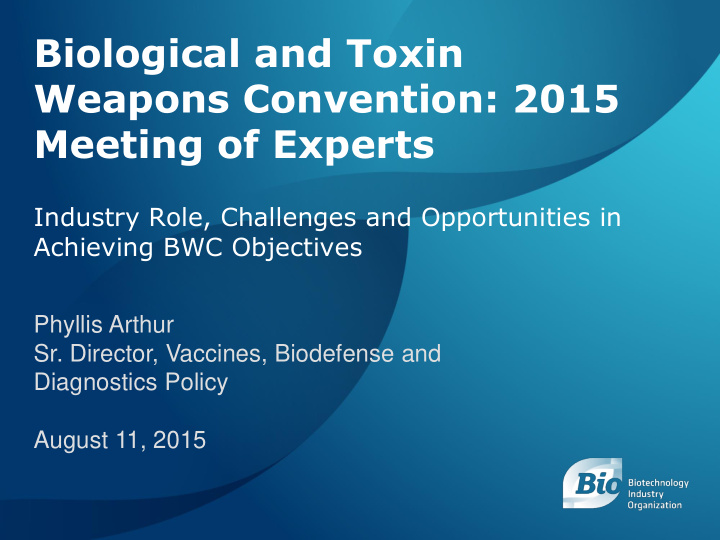



Biological and Toxin Weapons Convention: 2015 Meeting of Experts Industry Role, Challenges and Opportunities in Achieving BWC Objectives Phyllis Arthur Sr. Director, Vaccines, Biodefense and Diagnostics Policy August 11, 2015 1
Biotechnology Innovation Organization World’s largest trade association for biotechnology companies, academic institutions, state biotechnology centers, and related organizations – More than 1,000 members BIO Sections: Healing, Feeding, and Fueling the World – Health – Food & Agriculture – Industrial & Environmental – Emerging Companies Infectious Disease Policy Areas of Focus – Vaccines – Biodefense – Antimicrobial Resistance – Diagnostics 2
Industry capabilities in infectious disease are vital to preparedness and response Actively develop novel vaccines, therapeutics and diagnostics – Classic medical countermeasures: smallpox, anthrax – New emerging infectious diseases: Ebola, MERS, chikugunya Invest in new platform technologies that can speed identification, investigation, development and production of vaccines and other products Serve as an intersection between government, academia and NGOs in the identification and prioritization of needs for therapeutics, vaccines, and diagnostics Support healthcare delivery infrastructure (i.e., vaccine delivery, surveillance, detection, attribution) Educate policy makers and clinicians about healthcare issues 3
Possible Roles of Industry Partners In preparedness activities: – Help solve key scientific issues that act as barriers to product development; – Where unmet needs or threats are idenitified, industry can develop medicines, vaccines and diagnostics in anticipation of bio-threats, pandemics or potential outbreaks, for example anthrax antitoxin, pandemic influenza or smallpox vaccines; – Where there is the possibility of unknown pathogens or emerging threats, industry can help with the development of novel detection and diagnostic tools; – In additon, new platform technologies can allow for the rapid development of vaccines and treatments for unknown pathogens, as with Ebola and MERS. 4
Possible Roles of Industry Partners In Response activities: – Act as vital partner in the research, development and production of new vaccines, therapies and diagnostics; – Where feasible, assist in the development of technical expertise within countries; – Help facilitate the delivery of doses or medicines to countries in need of assistance through donation programs, as appropriate. 5
Global Challenges for Industry The economic viability for many products in this arena is uncertain or ill-defined. Government budgets are tight and therefore the normal funding for R&D is limited and divided now between classic medical countermeasures and emerging infectious diseases. The austere budget environment makes the procurement strategies unclear – will their be stockpiles in countries or routine purchase for specific countries? Global regulatory systems are fragmented and highly variable making approval and delivery of medicines and vaccines complex. Infrastructure in many countries for the delivery of infectious disease products is highly variable and may not be able to accommodate an urgent response. 6
Opportunities for Coordination to Help with Preparedness and Response Global threat assessment and prioritization could help industry best understand where to focus limited resources and allow for clearer public-private partnerships; Continued efforts to harmonize regulatory systems, particularly for emergency, pandemic and outbreak products, is a vital step to reducing the time and burden of delivering new vaccines and therapeutics; Global funding mechanisms to share the risk of development of both classic Medical countermeasures and emerging infectious disease products are needed to offset lack of funds; Possible regional procurement or stockpiling strategies could clarify the economic value of investing; Efforts to reduce other regulatory barriers, such as export permissions for products or unclear customs regulations, would speed outbreak response for all medicines. 7
8
Recommend
More recommend